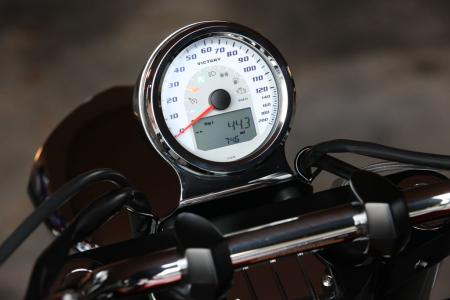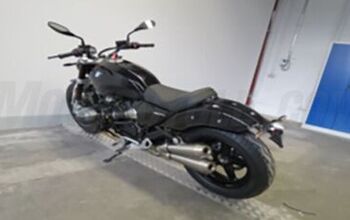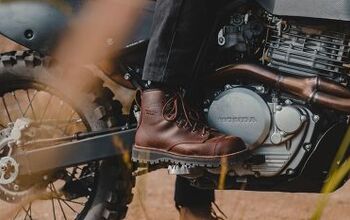2011 Victory Lineup Reviews - Motorcycle.com
Victory Motorcycles reminds me of Canada. Few people in the USA pay much attention to the nearly invisible Canucks, just as Victory cruisers are roundly overlooked by America's steadfast allegiance to Harley-Davidsons. You have a better chance of seeing a limited-edition CVO Harley on the road than you will riding alongside any Victory model made in the firm’s 13-year history.
But lest you think Victory might be going the way of the Dodo bird (or Buell, R.I.P….), you should be aware that sales of the Polaris Industries spin-off were up 48% in the second quarter of 2010, despite a lackluster economy and a general shrinking of the two-wheel market – the 1400-plus-cc market is down 14% in North America this year. It was also Victory’s third consecutive quarter of increased market share and retail sales, thanks in large part to the successful Cross Country and Cross Roads light-tourers introduced late in 2009. In international markets, Victory sales are up 25%.
And for 2011 Victory continues to evolve its lineup via several engineering improvements, including the adoption of the 106 cubic-inch V-Twin across Vic’s entire lineup. The 106/6 was previously available only on the Vision, Hammer, Jackpot and the hot-rod Vegas LE).
The 106-incher comes in two states of tune. The Stage 1 version in Victory’s touring lineup produces a claimed 92 hp and 109 ft-lbs of torque. The cruisers receive the slightly hotter Stage 2 iteration with lumpier cams claiming 97 hp and 113 ft-lbs. Victory Engineering’s James Holroyd notes that the enlarged 1731cc motor offers 14% more horsepower at no increase in price. We can get behind a program like that!
Upgrades to Victory’s powertrain also include a totally re-worked 6-speed transmission that promises smoother shifting, easier neutral access, and 100,000-mile durability.
Victory claims a 66% decrease in driveline lash via the use of “hi-lo dog/pocket” design, and alternating heights of the gear dogs are said to result in a better fill of pockets while increasing the likelihood of engagement. Shift forks have been redesigned for increased bending resistance, and selector drum tracks have been reprofiled to ease shifting. Durability is upped thanks to a larger bearings and wider gear-sets for 4th and 6th gears. A Neutral Selection Assist feature eases access to neutral even after clutch degradation, helping extend the range for oil service from 3,000 miles to 5,000.
But more importantly, Victory has alleviated the annoying whine from the previous tranny’s spur-type gears by employing new helical-cut gears. These reduce noise dramatically, a significant 6 to 10 dBA, depending on which gear is chosen, now allowing Victory’s touring models to meet Euro noise regs. The quieter gears (including a primary-drive gear-tooth geometry tweak) have a nice side benefit of letting engineers hog out the size of the exhaust’s outlet tips to emit a more satisfying rumble from the tailpipe.
Although Victory didn’t release any fully new models for 2011, several updates have spread through the line in addition to the 106-cube motor and reworked transmission. Here’s a list of this year’s upgrades.
| 2011 Victory Upgrades |
| * New instruments for cruisers and Cross Roads. An analog speedo is joined by an LCD panel that includes a clock, gear-position indicator and numeric tach. It is backlit by a cool blue hue. |
| * Warning lights now in the gauge pack rather than inserted in the triple clamp |
| * New gear-position indicator that uses a calculation to determine which gear has been selected |
| * New 48-amp charging system across all models, with increased output at low revs |
| * Black switchgear housings |
| * New sidestands that are less bulky but easier to access |
| * Kingpins have their floorboards pulled back 2 inches |
| * The Vegas line has a new handlebar that reaches back an extra 2 inches compared to 2010 models. |
8-Balls
As in previous years, Victory is offering the stripped-and-black 8-Ball series to appeal to budget-minded riders. The ‘Balls are the least expensive way into the Victory fold, and the 2011 Vegas-8 is $1,300 cheaper than last year.
The black Ball series is now spread across four platforms: Vision ($17,999), Vegas ($12,499), Kingpin ($12,999) and Hammer ($14,499). The latter three models now have black ceramic-coated exhaust systems and a black bullet headlight first seen on the ’06 Jackpot.
Although the Minnesota-based business is keen to keep a lid on production costs, company reps tell us that nothing Victory is to be built at Polaris’ Mexico facility. In fact, the company will be consolidating production at its Spirit Lake, Iowa, factory, combining engines and chassis under one roof.
Road Testing
To sample its entire 2011 lineup, Victory invited the press to Gateway, Colo., an upscale resort south of Grand Junction along the wonderful Highway 141 that wends through a canyon’s glorious rock walls. It’s like a smaller-scale Grand Canyon you can ride through.
Unlike living in SoCal, where minutes and seconds are worries, the canyons here make a rider step back and reflect on the enormity of time that stretches almost infinitely longer than the pathetically short little lives of humans.
We made ourselves busy jumping from one bike to the next, sampling everything Victory has to offer. Below you’ll find mini bike reviews of each.
The 106/6 powertrain upgrades are immediately noticeable, with the bigger motor cranking out more horsepower and torque than previous. It provides a broad and strong powerband, chugging away nicely from as low as 1500 rpm. Throttle response is very smooth. A shorter-turn throttle would allow an easier reach to the EFI’s full bore.
The new tranny’s helical-cut gears are massively quieter than the previous whiny gears, especially noticeable in 6th gear when you want to rumble down the road in peace. Shifts are notchier and higher-effort than we expected from a newly designed gearbox, but gear swapping is more precise and direct than previous.
The new single-unit gauge pack is a success. It’s mounted high and is quite visible, with its functions controlled via a button at the forward end of the left-side switchgear. Its clock and GPI are always on. The numeric tach isn’t particularly easy to read, but it’s at least nice to be able to refer to one – at 60 mph in sixth gear, it’s showing 2100 rpm.
All Victorys are fitted with Nissin 4-piston calipers and 300mm front discs acted upon via braided steel brake lines, and they offer reasonably good feel at the lever. The Kingpin and Vegas models have only a single front disc, while the Hammer, Cross bikes and Vision sport dual discs that supply strong power. All Victorys are backed up by a 300mm rear rotor and 2-piston caliper. The Cross Roads/Country still aren’t available with ABS, but an anti-lock system is now standard of the luxurious Vision tourer.
Also of note: Each Victory has a set of self-canceling turnsignals, which prevents the annoying (or dangerous) situation in which a careless rider can go for miles with a signal blinking for no apparent reason. It functions cleanly, and we applaud this feature (shared with H-D) and wonder why most other OEMs don’t use something similar. It’s a real convenience, plus it may have safety implications.
Mini Reviews
Vegas
When the Vegas debuted in 2003, it became the Victory to receive favorable styling reviews, and it’s now the cheapest way to get into the Victory club. This chopper-themed cruiser feels relatively thin and light, and this contributes to its easy-to-ride nature. Its seat height is listed at a diminutive 25.2 inches, 1.3 inches lower than the Kingpin because of a shorter rear shock. Its new handlebar is less of a stretch for short arms.
The 43mm conventional fork exhibited a slight excess of high-speed compression damping, occasionally causing a harsh reaction through the bars. The rear suspension’s 3.0 inches of travel isn’t as compliant as the Kingpin’s 3.9 inches.
An 8-Ball Vegas is available for just $12,499, or you can upgrade to the Solid Crimson Vegas for $2,000 extra. The Imperial Blue & Pearl White version we sampled retails for $14,999.
Kingpin
The Kingpin is the sharpest-handling Victory, sporting a 130/70-18 front tire as opposed to the narrow 90/90-21 on the front end of the Vegas. This extra rubber width helps it track through corners and puts a bigger contact patch up front so the single-disc brake system has more bite on the road. The ’Pin also handles better at low speeds, but it drags its floorboards at about the same lean angle the Vegas scuffs its pegs.
Other than the aforementioned seat height, the KP also stands apart from the Vegas by its inverted fork and its big, flowing fenders, adding about 20 lbs to the package. A rider is faced with a black triple clamp with chrome insert and chrome fork caps, as well as the attractive and tidy new gauge pack. A frenched-in LED taillight caps off the curvaceous rear end. Ergos are comfy, with the relocated floorboards accommodating journalists of all sizes.
Kingpin prices start at $12,999 for the black 8-Ball stripper, vaulting to $14,999 for the rich Solid Crimson version. A two-tone version is available for $300 extra.
Vegas Jackpot
The Jackpot is the bar-hopper in Victory’s lineup, with a fat 250mm rear tire adding curbside appeal while compromising suspension compliance and steering dynamics. A skinny 21-inch front wheel does more to complete a look than enhance performance.
The Jackpot is a tough-looking bike, but it lacks the versatility of other Victorys. It starts at $18,499 in basic black, rising to $19,999 for either of the two Extreme Graphics versions.
Cross Roads
The Cross bikes might be the most thoroughly developed platform in Victory’s catalog, Both the Cross Roads and Cross Country offer neutral steering that is solid and secure, and they have more ground clearance than the cruisers, even if they weigh 90 extra pounds.
For 2011, Victory is hitting the lucrative touring market harder with what it calls the Cross Roads Core Custom Program. The starting point is the base Cross Roads, retailing for $14,999 with its standard cruise control and removable soft saddlebags (which Victory claims are the biggest in the industry).
Other accoutrements can be ordered up as the customer deems fit. A windshield costs $550; add $300 for locking hard bags. Or select your choice of two crash-bar options. Victory notes that an outfitted Cross Roads retails for $2,000 less than a comparably equipped Harley’s Road King, while having more power, increased storage and greater suspension travel (a generous 4.7 inches in back).
Cross Country
The Cross Country is Victory’s answer to the Street Glide and Road Glide, two perennial best sellers in the still-strong touring market. It has the same aluminum-frame backbone as the Cross Roads, but it adds a frame-mounted fairing and standard hard saddlebags. Inside the cockpit are niceties such as an MP3 compatible AM/FM stereo, cruise control, separate tach and speedo, plus fuel and volts on individual gauges, augmented by an LCD info panel with a GPI. The ‘Country’s audio system is improved by enlarging the speaker grill’s holes by 275% to better let the sound flow to your ears.
The CC starts at at $17,999 in solid black. Add another $500 for the Imperial Blue Metallic, or another $500 for the Pearl White & Vogue Silver two-tone version. We liked the Cory Ness Cross Country so much that we rode it to Sturgis to really discover what this stylish bagger is like to live with, so keep it tuned to Motorcycle.com to read that review.
Vision Tour
Okay, its avant garde swoopy styling hasn’t quite meshed with traditionalist sensibilities, but we are growing more accustomed to the Vision’s daring design as time rolls on. The Vision is bequeathed with good stuff like a power windscreen, heated seats and handgrips, cruise control and an HID headlamp. Gauges include a trip computer, average mileage and ambient temperature. It has 29 gallons of storage in its small bags and large trunk.
ABS brakes now come standard at the same MSRP as in 2010. Other updates include textured black passenger grabrails to minimize scuffing, and the saddlebags were made easier to open by the simple removal of the bags’ hydraulic dampers.
Its controversial style aside, the Vision proves to be a great over-the-road performer. It’s very comfortable, its windscreen can be adjusted to suit nearly anyone, and its aluminum frame offers a stout and reasonably light chassis. But it weighs 100 lbs more than a Cross Country, and its side cases are smaller than the CC’s hard-shell saddlebags. What’s more, all that luxury starts at a lofty $23,199 in Solid Pearl White.
Arlen’s grandson created the newest Ness, the subtle and low-gloss Zach Ness Vegas. This stripped-down cruiser’s long and low attitude is capped off by a suede-like paint finish and custom graphics against a matte-black frame. Wheels in an attractive double 5-spoke design are machined from billet aluminum and are complemented by Victory’s Holeshot billet pegs and grips. A custom-stitched leather seat indicates the bike is special even if an observer fails to notice the signed engine number plate. Zach’s bike retails for $18,999.
The Arlen Ness Vision makes another run for 2011, now in black with scrolled graphics and equipped with trunk and ABS. The bike’s billet wheels have a matching scroll pattern engraved into the spokes, as does the electrically adjustable windshield. Diamond-cut cylinder fins add to the brightwork that includes special billet grips, foot controls, mirrors and engine covers. The Ness version of a Geezer Glide rings in at $27,999.
Cory Ness applies his touches to the successful Victory Cross Country, a new Ness model for 2011. Again we see Ness chromed billet grips, foot controls and passenger pegs, plus diamond-cut cylinder fins and a custom chrome handlebar. Mirrors, engine covers and the oil line cover are brightly chromed, as is the CC’s uniquely shaped highway bars. Billet “Anvil” wheels add further customization touches, as does the suede seat and a nicely done ghosting of “Victory Motorcycles” logo under the Sunset Red paint’s clear coat. A signed engine number plate helps justify the bike’s $24,999 MSRP.
Victory is confident in the quality of its offerings, having received 95% customer satisfaction scores in a 2008 survey. It understands that getting more butts in their seats offers the best chance at converting the wary (and the Harley faithful), so the company has doubled its demo-fleet trucks (to 6) and is on pace to triple the number of annual demo rides to about 21,000.
Maybe you’ll be the next convert…?
Related Reading
Victory Q2 2010 results
2011 Victory Motorcycles Lineup
2010 Harley-Davidson Road Glide vs. 2010 Victory Cross Country
2010 Victory Motorcycles Lineup Preview
Victory Vegas 8-Ball Project: Part 1
2010 Victory Vegas 8-Ball Review
2009 Victory Cory Ness Signature Jackpot Review
All things Victory on Motorcycle.com
More by Kevin Duke










































Comments
Join the conversation